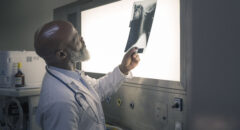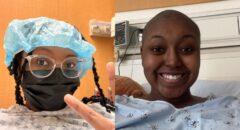 While most skin cancers are caused by unprotected exposure to the sun, research pinpoints less obvious risks for developing the abnormal growth of skin cells.
While most skin cancers are caused by unprotected exposure to the sun, research pinpoints less obvious risks for developing the abnormal growth of skin cells.
Per the Skin Cancer Foundation, there's a common misconception that darker skin tones aren't at risk for skin cancer. However, a 2016 study in the Journal of the American Academy of Dermatology found that African Americans are more likely to be diagnosed with melanoma in later stages and have a lower overall survival rate.
says dermatologist Maritza I. Perez, MD, a senior vice president of The Skin Cancer Foundation.
“Anyone can get skin cancer, regardless of race,” said Maritza I. Perez, MD, dermatologist and a senior vice president of The Skin Cancer Foundation.
She added,“Remember, ethnicity does not define skin type. It can represent a wide range of skin tones with a wide range of risks.”
So, what factors are responsible for the over 5.4 million cases nationwide of nonmelanoma skin cancer in more than 3.3 million people each year? The risks may surprise you.
1. Citrus juice
Research published in the Journal of Clinical Oncology suggests that downing one cup of grapefruit or orange juice more than 1.6 times daily is associated a 36 percent increased risk of developing melanoma. Scientists speculate it's due to the fruits high level of psoralen and furocoumarin compounds, which are believed to make skin more photosensitive or extremely sensitive to sunlight (UV rays).
2. Ginger-headed relatives
Believe it or not, gingers have it bad! And by bad, we mean that whether you’re a red head (or not), new research published in Nature Communications indicates that simply carrying the gene that gives you red hair leads to 42 percent more sun-associated genetic mutations (like skin cancer) when compared to people who don’t carry the gene.
3. HPV
A study published in the British Medical Journal discovered a connection between strains of HPV and the occurrence of squamous cell carcinomas – a common form of nonmelanoma skin cancer, that develops in the “squamous” cells that make up the middle and outer layer of the skin. The more strains of HPV a person carries, the greater their risk of developing the squamous cell cancer in their lifetime.
4. Tanning
Bump what you’ve heard, hitting the tanning bed – which exposes users to two types of UV rays: UVA and UVB – is bad news! In fact, science shows that it can lead to premature skin aging such as wrinkles, brown spots, and let’s not forget, skin cancer. Furthermore, research shows that people who use an indoor tanning bed before the age of 35 increase their risk of melanoma by up to 75 percent. If you ask us, that’s reason enough to stay clear of the popular trend.

5. Wine
Specifically, white wine has been linked to a 13 percent increased risk of melanoma, according to a study published in Cancer Epidemiology, Biomarkers & Prevention. Meanwhile, an analysis of 16 studies (from 2014), published in the British Journal of Dermatology, found that turning up with more than one drink a day, is associated with a 20 percent increased risk of skin cancer. Researchers argue that the risk is due to the DNA-damaging enzyme acetaldehyde found in all alcoholic beverages but at higher levels in white wine.
Tip: Opt for red wine instead. Not only is your risk of developing melanoma lessened, but it’s loaded with heart-healthy benefits like antioxidants such as flavonoids which have been linked to regulating blood sugar, boosting memory, fighting the common cold and preventing cancer.








